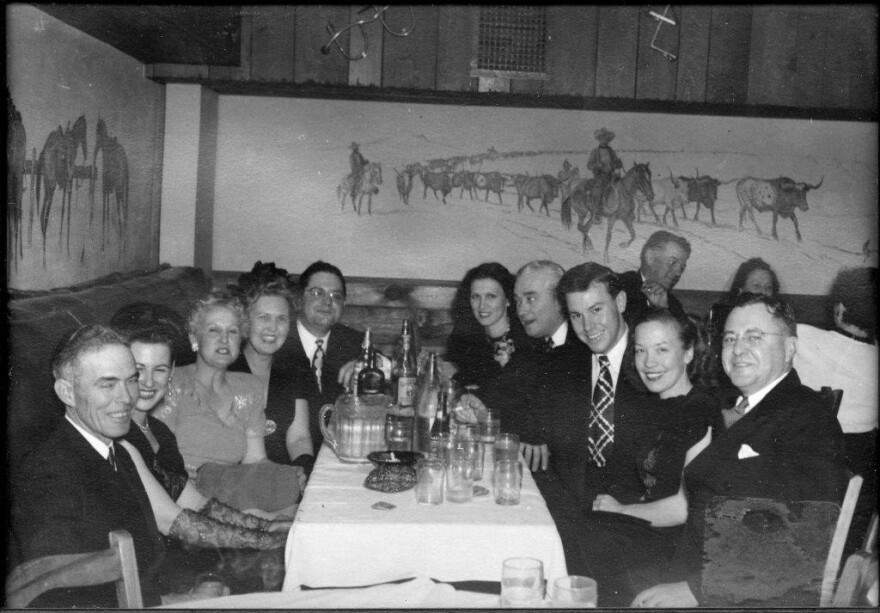The worn-slick saddle encased in Plexiglas is not a standard fixture of the Kansas City Public Library’s grand, marbled entry hall. But it's not out of place, either, considering that the stately former First National Bank building, which opened in 1886, is a monument to how cosmopolitan the cattle industry once made our town.
More context for the saddle can be found upstairs in one of the library’s two galleries. “Cattle, Cowboys, and Culture: Kansas City and Amarillo, Building an Urban West” is a small but rich exhibition that glorifies frontier glamour while laying to rest what might be one of our country’s most destructive myths.
“The first thing Hollywood put in the cowboy’s hand was a gun and unfortunately that’s not something that was a normal part of a cowboy’s tool kit,” one of the exhibition’s curators, Michael Grauer, told Steve Kraske on KCUR’s Up to Date last month. “A man mounted on the back of a horse doing cow work really had no need for a firearm. And frankly, they got in the way.”
Guns are in the exhibit — one beautiful Sharps rifle and a couple of Colt revolvers — along with other cattle-drive necessities such as buffalo-skinning knives and ropes, also in glass cases at the front of the gallery as if to dispense early with the idea that guns were a big thing with cowboys.
It's hard to find any guns at all in the pictures of real cowboys working on the trail.

"In popular culture, cowboys become gunmen and ultimately crime fighters and superheroes, when regular cowboys didn’t do any of that," said Grauer, who grew up in Kansas City and is now associate director of curatorial affairs and curator of art and western heritage at the Panhandle Plains Historical Museum in Amarillo, Texas.
"A lot of young men came out West expecting to be riding around all day and having a good time on back of a horse," he said. "They found out pretty soon it was hard work, it was dirty, it was dangerous and largely it was boring because you’re dealing with animals that are dumb as a box of rocks when you’re talking about cows. It doesn't get too exciting."
But the industry did generate excitement in the two big cities at either end of one significant trail, thanks to the ranches around Amarillo and the stockyards in Kansas City. The other big surprise in the library's exhibition is the similarity between the two cities' culture, architecture and urban design.

Besides embracing George Kessler's "City Beautiful" idea of urban planning, which resulted in Kansas City's vaunted parks and boulevards, Amarillo took shape partly thanks to the Kansas City architecture firm of Shepard, Farrar & Wiser.
"Between 1910 and World War II, Shepard, Farrar & Wiser continued to build not just in Kansas City but in other locations, including all around Amarillo," says Amy Von Lintel, Grauer's co-curator for the library's exhibit. Also a Kansas City native, Von Lintel is now an associate professor of art history at West Texas A&M University.
Today, Amarillo is a tedious nine-hour drive from Kansas City. But Kansas City was closer to Amarillo than Chicago, and in cattle-drive days, the city was advertised as more convenient than Denver or Fort Worth, Texas, Von Lintel says.
"Not only cattlemen but also ranch hands and cowboys would travel to Kansas City to go shopping, get medical services and purchase goods, and things like furniture would be brought back here by train," Von Lintel says. "Or people would order something in a catalog and the train would bring it down."
Cattle were "the currency for these continued relationships," Von Lintel says.
"You see how important the cattle industry was to dress fashion: Women would go with their husbands shopping. Women who were on these ranches went to Kansas City to deliver their babies. Kansas City was like New York," Von Lintel says.
Some of those fashions are also on display at the library, along with other artifacts such as dishes, matchbooks and postcards from the two cities' Shepard & Wiser-designed hotels: Kansas City's President and Amarillo's Herring.

Though it was a city on the rise in the early 20th century, Amarillo never grew like Kansas City did, Von Lintel says. And the interstate highway system's lack of a direct route between the two cities made it easy to forget their one-time sister-city relationship.
And Kansas City grew prickly about its cow-town reputation.
"The era of Kansas City as a cow town has almost been suppressed — it's not the bragging rights of Kansas City anymore," Von Lintel says. "There was something low-brow that Kansas City hasn’t wanted to embrace. But if you look back on those days, Kansas City was a progressive center with its architecture and the city beautiful movement."
Kansas City is, however, slowly starting to re-appreciate this aspect of its identity, branding the Stockyards District, holding festivals in the neighborhood and promoting the heritage of the West Bottoms.
For folks who are so inclined, "Cattle, Cowboys, and Culture" provides plenty of new fodder.
"Our exhibition shows that it’s more than mythology," Von Lintel notes, "that made Kansas City a leading 20th Century city."
“Cattle, Cowboys, and Culture: Kansas City and Amarillo, Building an Urban West,” through March 18, 2018 at the Kansas City Public Library, 14 West 10th St., Kansas City, Missouri, 64105; 816-701-3400.
C.J. Janovy is an arts reporter for KCUR 89.3. You can find her on Twitter, @cjjanovy.





